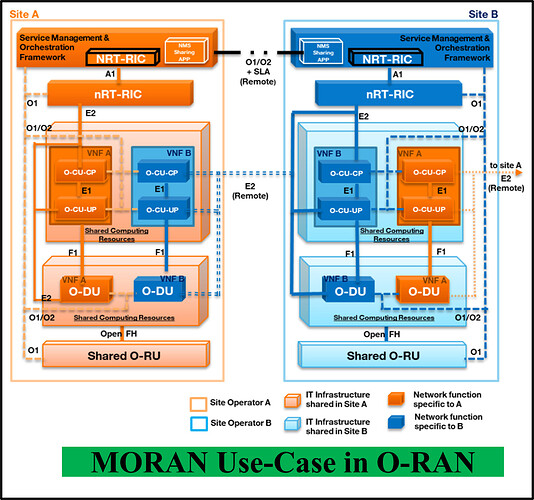-
My friend: Hi Ibrahim, I have a question for you.
- Me: Please, go ahead.
-
My friend: I was wondering what is meant by O-RAN use cases?
- Me: O-RAN Use Cases are the cases defined by O-RAN Alliance and the target of these uses cases is to leverage the O-RAN architecture by utilizing AL and ML to control the real time behavior of RAN and focusing on optimizing RAN via configurations to improve the performance of RAN more and more. So, these use cases are very specific and focuses on specific topics to improve it such as traffic steering, massive MIMO and Beamforming, RAN sharing, RAN resources optimization, slicing, DSS, energy saving, and more.
-
My friend: So, could you give me one example of these O-RAN use cases?
- Me: So, let’s speak about RAN Sharing, the below figure is showing the architecture of the proposed MORAN (Multi Operator RAN) use case. So, we are assuming here two operators A and B are sharing the same RAN infrastructure but using different spectrum and with different core networks. So, Operator A owns site A and shares the PHY Layer (LOW) with Operator B using a shared O-RU and the same applies for operator B who owns site B. Moreover, site A hosts VNF instances of Operator B in a shared O-DU and O-CU site. Specifically, the computing resources of the site A are shared among multiple VNFs, belonging to the operator A and B respectively. Each VNF represents a logic implementation of the O-DU and O-CU functionalities and should be controlled by each operator in an independent manner.
-
My friend: So, is RIC shared between the operators or not?
- Me: No, RIC isn’t shared and are independent from each other at site A and site B. Note also that Operator A can directly control its VNFs and Operator B needs to control its VNFs in a remote manner inside site A. The challenge here is to enable Operator B to control resources in an infrastructure that is owned by another operator. Accordingly, it is assumed that Operator B can monitor and control the remote resources via the RIC node of site B. The proposed MORAN sharing architecture lets operators configure shared network resources independently from configuration and operating strategies of the other operators facilitating the optimization of the radio allocation process and the remote configuration of QoS parameters.
-
My friend: Thank you so much. You made it very clear.
- Me: You are most welcome.
LinkedIn: Ibrahim Sayed, PMP on LinkedIn: #5g #5gnr #5gtechnology | 17 comments
